Geese are large, heavy birds from the large waterbird family Anatidae. They’re divided into two genera; the white and grey geese from Anser and the black geese from Branta. The UK hosts a total of nine different species of geese, but only three breed here - the Canada goose, the Greylag goose and a small quantity of Barnacle geese.
Geese are hardy birds that breed in some of the coldest regions on Earth, and many migrate to the UK from Iceland, Greenland, Scandinavia and Russia.
Some geese even head all the way across the Atlantic from Canada to Ireland! The UK winter is pretty mild compared to some of the locations geese choose to breed in.
These robust, stocky birds have played an important role in human history, hence why there are so many idioms involving geese, “cooked his/her goose”, “have a gander”, and “wild goose chase”, etc.
This is a complete guide to identifying the species of geese found in the UK!
Common British species of Geese in the UK
The following geese are the most common in the UK, depending on where you are.
Canada Goose
Branta canadensis
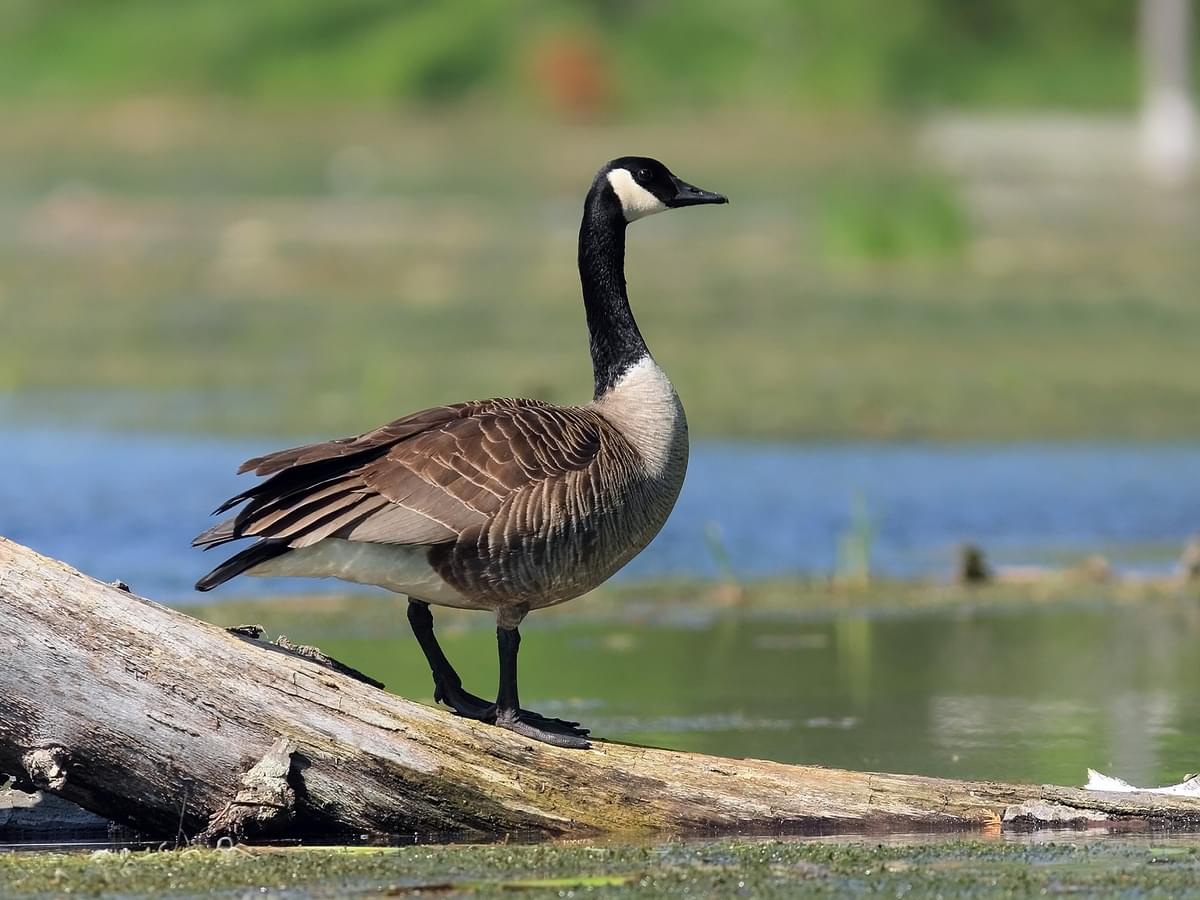
Length
76-110cm
Wingspan
127-185cm
Weight
3-9kg
Canada Goose
Canada geese were first introduced to the UK in the 17th-century in St. James's Park, London. The explorer Samuel de Champlain sent Canada geese to France for King Louis XIII, and they caught the eye of King James II, who added them to his waterfowl collection.
The rest is history, you could say! There are now well over 62,000 breeding pairs of Canada geese in the UK. In addition, wintering numbers are boosted by geese from other parts of northern Europe.
It’s no secret that Canada geese have a bad reputation, but this is largely unfounded. They’re so common because they’re so successful - and exceptionally tough and dedicated to raising chicks.
Moreover, Canada geese have a kind, gentle temperament and are only threatening when someone disturbs their eggs or chicks - which you’d have to say is justified!
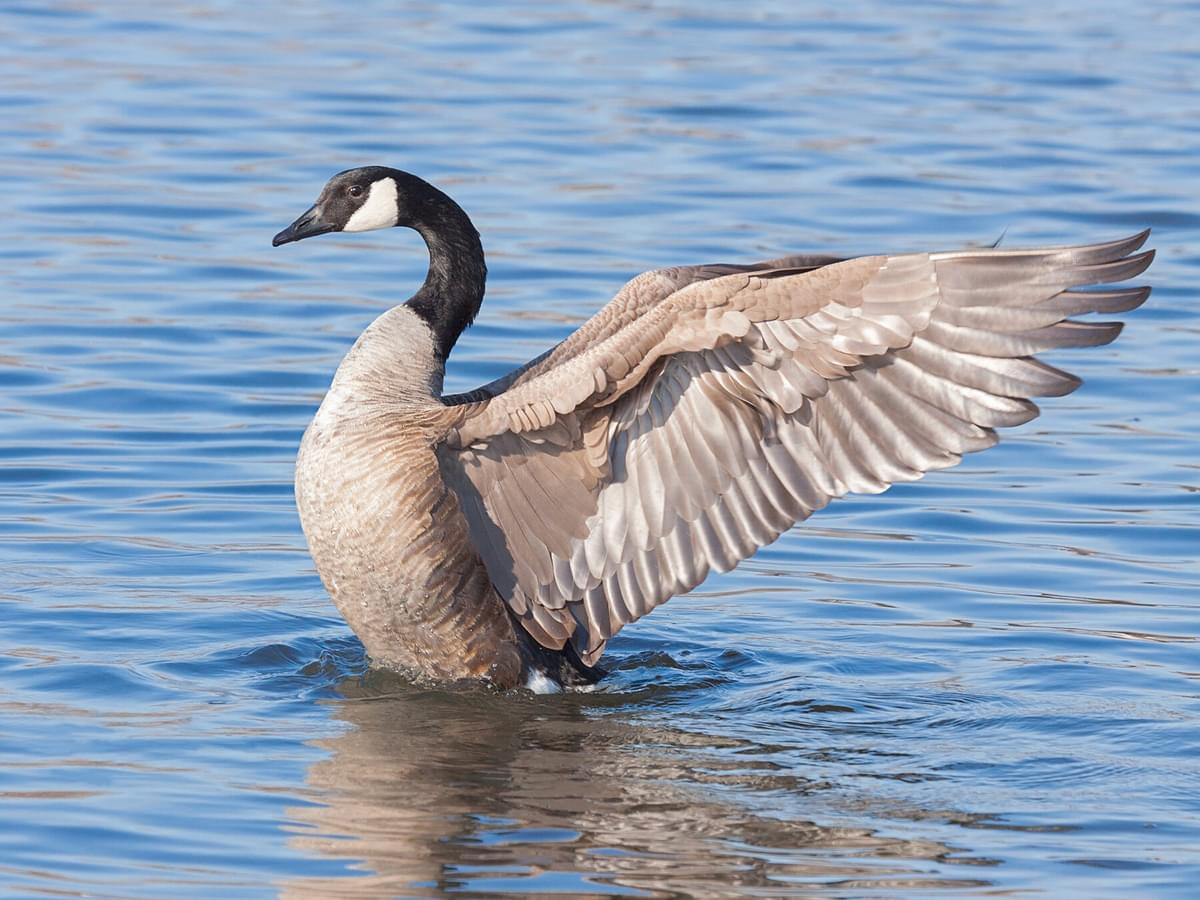
Close up of a Canada Goose rising out of the water
Appearance
Canada geese measure 75 to 110cm (30 to 43in) in length and have a wingspan of 127 to 185 cm (50 to 73 in). They weigh up to around 5kg, with exceptional males approaching 8kg.
There are several subspecies of Canada goose, but the Atlantic Canada goose subspecies is the most common in the UK. They have a grey chest, brown wings and flanks, and a muddy-white undertail. Their necks are black with a white facial stripe.
Greylag Goose
Anser anser
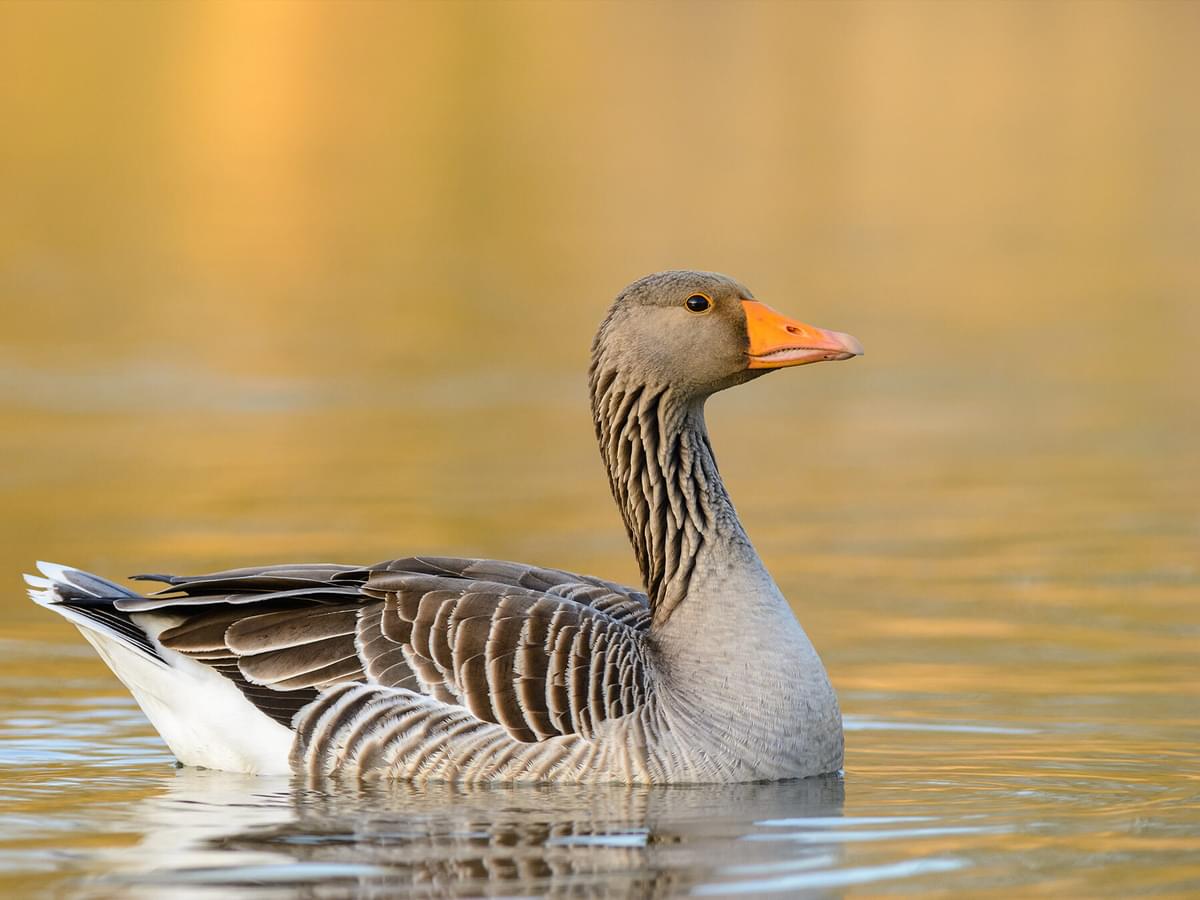
Length
75-90cm
Wingspan
147-180cm
Weight
2.5-4.1kg
Greylag Goose
The Greylag goose is the UK’s only native breeding goose. There are some 46,000 breeding pairs in the UK, and winter numbers are boosted by some 80,000 migrants from Iceland.
Wild Greylags are mostly distributed in Scotland, coastal Wales and east England, but they can be spotted in practically any lowland area, including parks and suburban areas.
Greylag geese supposedly earned their name as they’re slow to migrate and typically wait until November or even December to migrate, thus ‘lagging’ behind other geese.
Greylags have a long and illustrious role in human history - they were linked to the Sumerian goddess of healing and Aphrodite, the Greek goddess of love.
Appearance
Greylag geese are the bulkiest members of the Anser genus. They measure 74 to 91cm (29 to 36in) long with a wingspan of 147 to 180cm (58 to 71in). They weigh between 2.16 to 4.75kg.
They’re primarily brown-grey with a lighter brown breast and white undertail. Their necks are also lighter brown. Greylags have pinkish feet and an orange bill.
Brent Goose
Branta bernicla
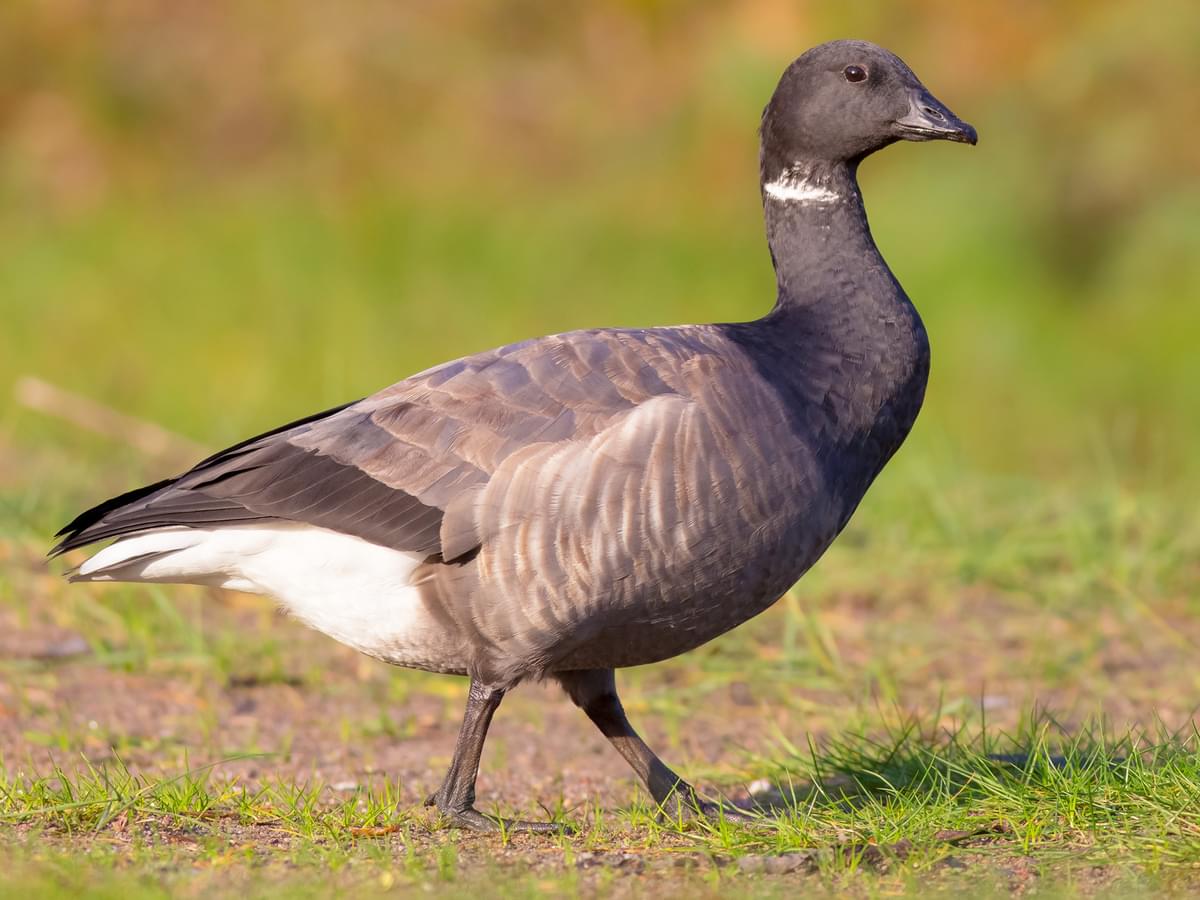
Length
55-66cm
Wingspan
105-117cm
Weight
1000-2500g
Brent Goose
The Brent goose only visits the UK in winter, completing a long journey from Russia, Scandinavia and Greenland. Two main populations migrate to the UK; the Pale-bellied subspecies and the Dark-bellied subspecies.
The Dark-bellied Brent goose migrates from northern Russia and Siberia, whereas the Pale-bellied Brent goose migrates from Greenland, Svalbard and other parts of western Scandinavia.
In winter, there are approximately 100,000 of these geese in the UK, with eastern populations migrating to southern England and East Anglia and western populations migrating to the North East and Ireland.
You’re most likely to see Brent geese in October through till March, when they leave UK shores for their breeding grounds.
Appearance
The Brent goose is very dark - pretty much black and belongs to the Branta genus. It’s the smallest goose seen in the UK - they’re roughly the same size as a Mallard duck.
These geese measure 55 to 66cm (22 to 26in) long with a wingspan of 106 to 121cm (42 to 48in) and weigh 0.88 to 2.2 kg (1.9 to 4.9lb).
Brent geese have dark grey-brown backs, a white undertail and dark black necks and heads. They have a small white patch across the neck. Their bills are also distinctively black.
Barnacle Goose
Branta leucopsis
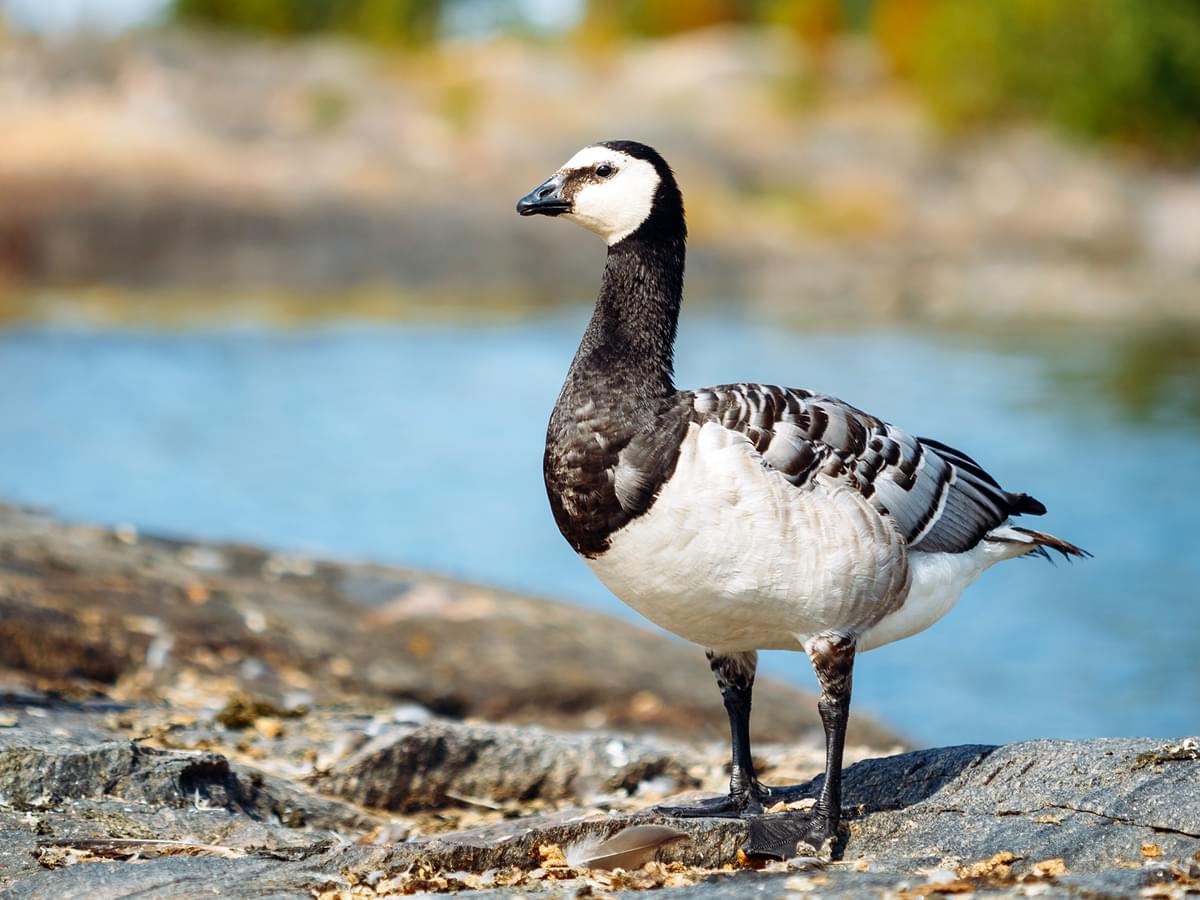
Length
58-70cm
Wingspan
132-145cm
Weight
1.3-2.27kg
Barnacle geese primarily migrate to the UK from Greenland, Svalbard and northern Russia. Approximately 58,000 arrive from Greenland and 33,000 from Svalbard and northern Russia.
They’re most likely to be seen between October and March, and are concentrated across the coastlines of Wales, Scotland and northeast England.
These small, robust geese form long lines when migrating, and their long perilous journey was once considered somewhat of a mystery. In the Middle Ages, people thought they hatched from the Goose barnacle at sea - hence the name Barnacle goose! They were even considered seafood!
Some Barnacle geese do breed in the UK - around 1,000 pairs or so. These feral populations can pop up practically everywhere - they were even sighted at Abbey Wood, in London.
The Barnacle goose is one of the most sociable species of goose and is often seen in large flocks, yapping at each other.

Barnacle Goose grazing for food
Appearance
Barnacle geese are relatively small, measuring 55 to 70cm (22 to 28in) long, with a wingspan of around 130 to 145cm (51 to 57in). They weigh about 1.21 to 2.23kg (2.7 to 4.9lb).
From the genus Branta, the Barnacle goose has a black head, neck and breast, with a distinctive white face. The wings are grey with bars that look somewhat metallic. They have shorter faces than some geese and a distinctively black bill.
Pink-footed Goose
Anser brachyrhynchus

Length
60-75cm
Wingspan
135-170cm
Weight
1.8-3.3kg
Pink-Footed Goose
The Pink-footed goose is another winter visitor to the UK. This medium-sized goose breeds in Svalbard, Iceland and Greenland and heads here around October, returning around April. The UK wintering population of Pink-footed geese is around 360,000.
They’re found primarily in Scotland, North West England and East Anglia, forming large gregarious flocks. Their numbers in England, particularly Norfolk, are on the rise.
You’re most likely to spot them along the Irish and Scottish coast, The Wash, East Anglia, the Ribble, Lancashire and the Solway, between Cumbria and Dumfries.
During migration, Pinked-footed geese form large skeins, which are V-shaped formations. They’re avid communicators and have a broad range of honk-like vocalisations in their repertoire.

Pink-footed Goose
Appearance
The Pink-footed goose is aptly named after its pink feet and legs. They have a grey-brown back with a white undertail and lighter brown breast. Their necks are also brown, and are quite short. The bill is brown with a pink stripe in the middle.
These are relatively large geese, measuring 60 to 75cm (24 to 30in) long with a wingspan of 135 to 170 cm (53 to 67in). They weigh around 1.8 to 3.4kg (4.0 to 7.5lb).
Greater White-fronted Goose
Anser albifrons
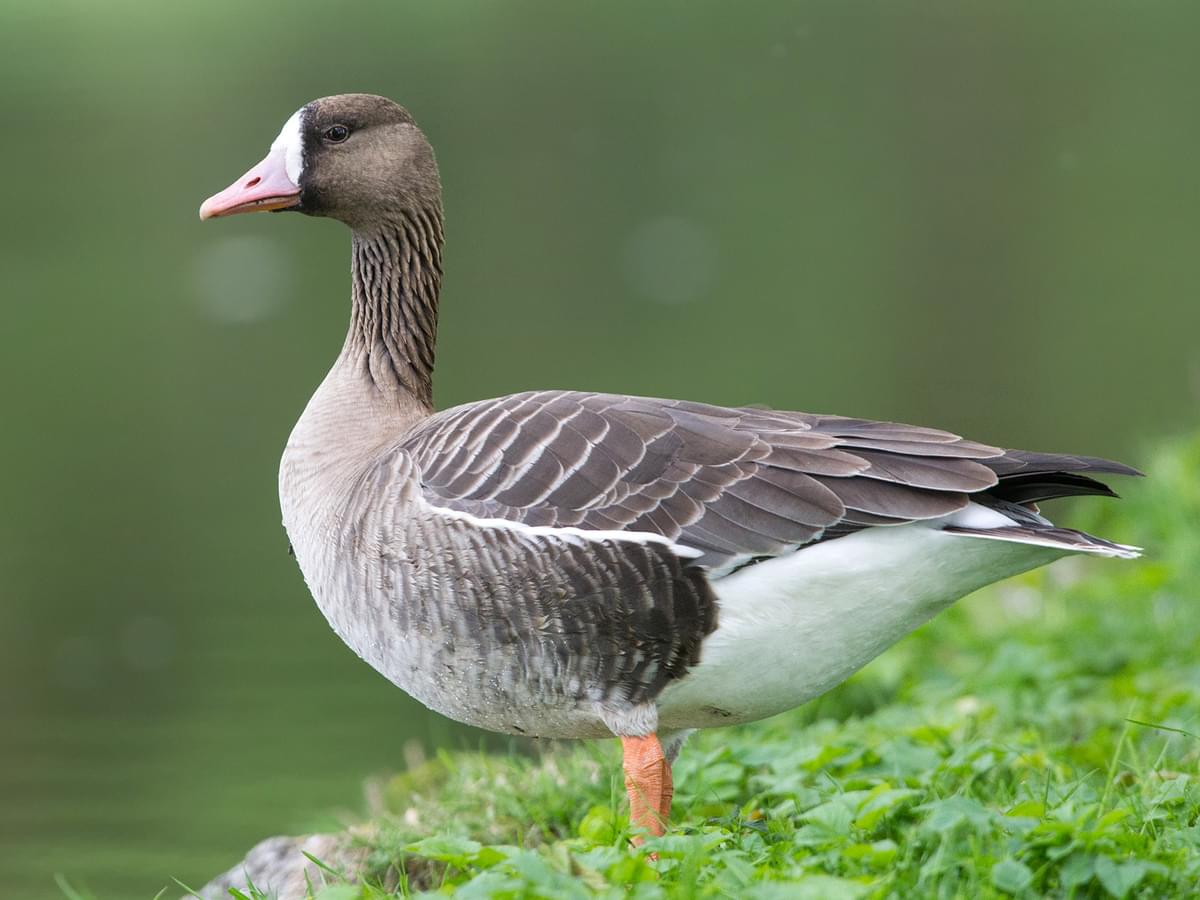
Length
64-81cm
Wingspan
130-165cm
Weight
1.8-3.3kg
Greater White-fronted Goose
There are two races - or subspecies - of Greater White-fronted geese that winter in the UK. One is the Greenland White-fronted goose; the other is the European White-fronted goose. The Greenland subspecies migrates here from Greenland, and is more common, with a winter population of around 13,000.
The European subspecies migrate here in October from northern Russia, Siberia and other parts of northern Europe, with a wintering population of around 2,400.
They leave for their breeding grounds around April. Despite not being a resident breeder, the White-fronted goose is on the Red List for UK birds, because its wintering grounds are reducing.
You’re most likely to see arrivals from Siberia across the Severn estuary in Gloucestershire and the Swale estuary in Kent. Arrivals from Greenland are more common in Ireland and West Scotland.
These geese are sociable and have a distinctive he-he call which is higher-pitched than most geese.

Greenland White-fronted goose

European White-fronted goose
Appearance
Belonging to the Anser genus, this is a medium-to-large-sized goose, measuring 64 to 81cm (25 to 32in) long with a wingspan of 130 to 165cm (51 to 65in).
They weigh around 1.93 3.31kg (4.4oz to 7.55oz). They have grey-brown wings and mouse brown upper wings, with a white undertail. Their faces have a distinctive white stripe across the front. The feet are bright orange.
The Greenland subspecies is much darker overall and has an ‘oily’ appearance.
Less common Goose species in the UK
The following geese are less common in the UK.
Tundra Bean Goose
Anser serrirostris
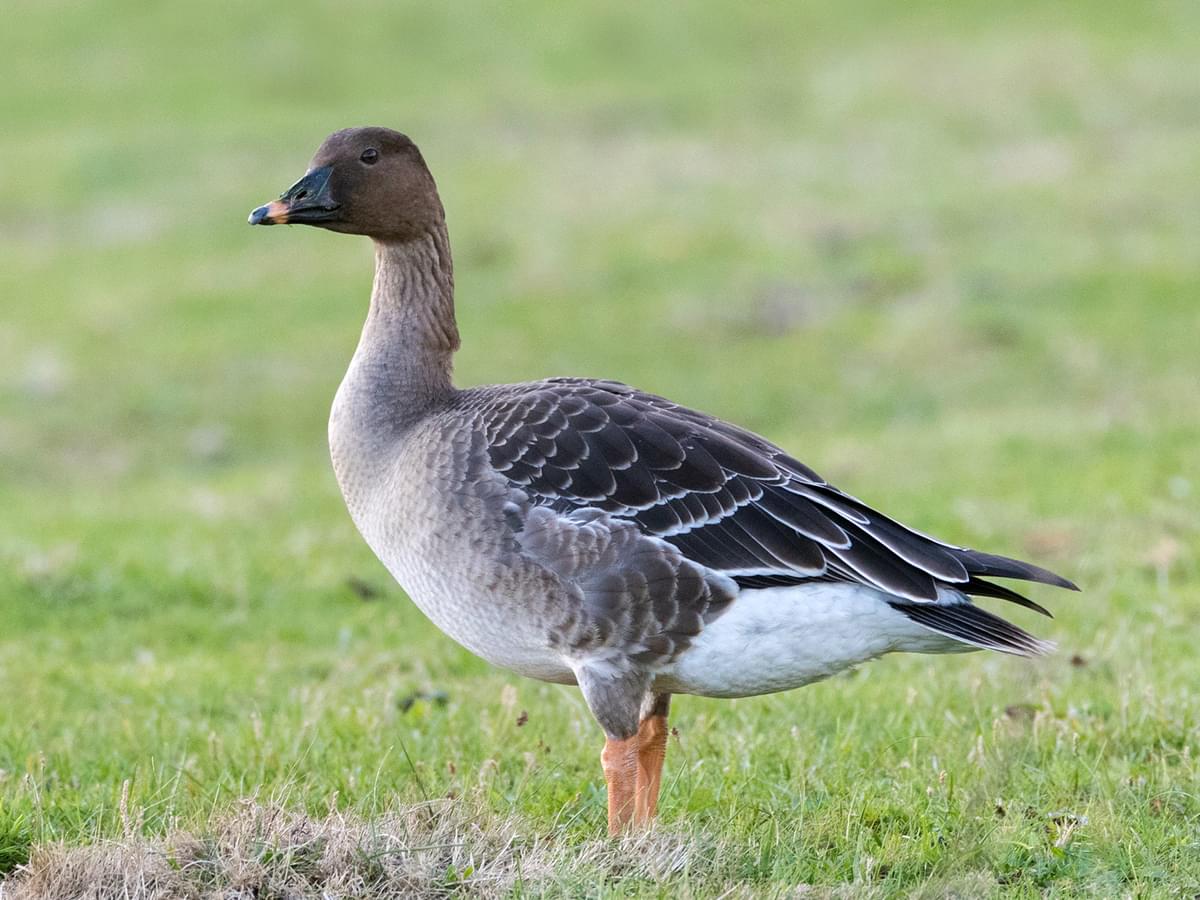
Length
66-84cm
Wingspan
140-174cm
Weight
1.9-3.3kg
Tundra Bean Goose
There are two subspecies of Bean-goose in the UK; the Tundra and Taiga Bean-goose. These were once considered the same species, but are now usually considered separate. The Tundra Bean-goose is less common than the Taiga Bean-goose.
It breeds primarily in the Russian tundra and winters across coastal Europe and throughout, with most birds settling north or east of the UK. isolated wintering populations occur on the Scottish and English east coasts.
It’s actually one of the most abundant species of European goose, with a total population exceeding 550,000.
The Tundra Bean-goose isn’t as gregarious as other geese and is usually found in smaller single-figure flocks.

Tundra Bean Goose
Appearance
The Tundra Bean-goose measures 68 to 90 cm (27 to 35in) with a wingspan of 140 to 174cm (55 to 69in). They weigh between 1.7 to 4 kg (3.7 to 8.8lb).
They’re predominantly grey-brown with a dark brown neck and lighter-brown breast. They have a black bill with an orange-yellow band, which identifies them from the Taiga Bean-goose with a different orange bill pattern.
Taiga Bean Goose
Anser fabalis
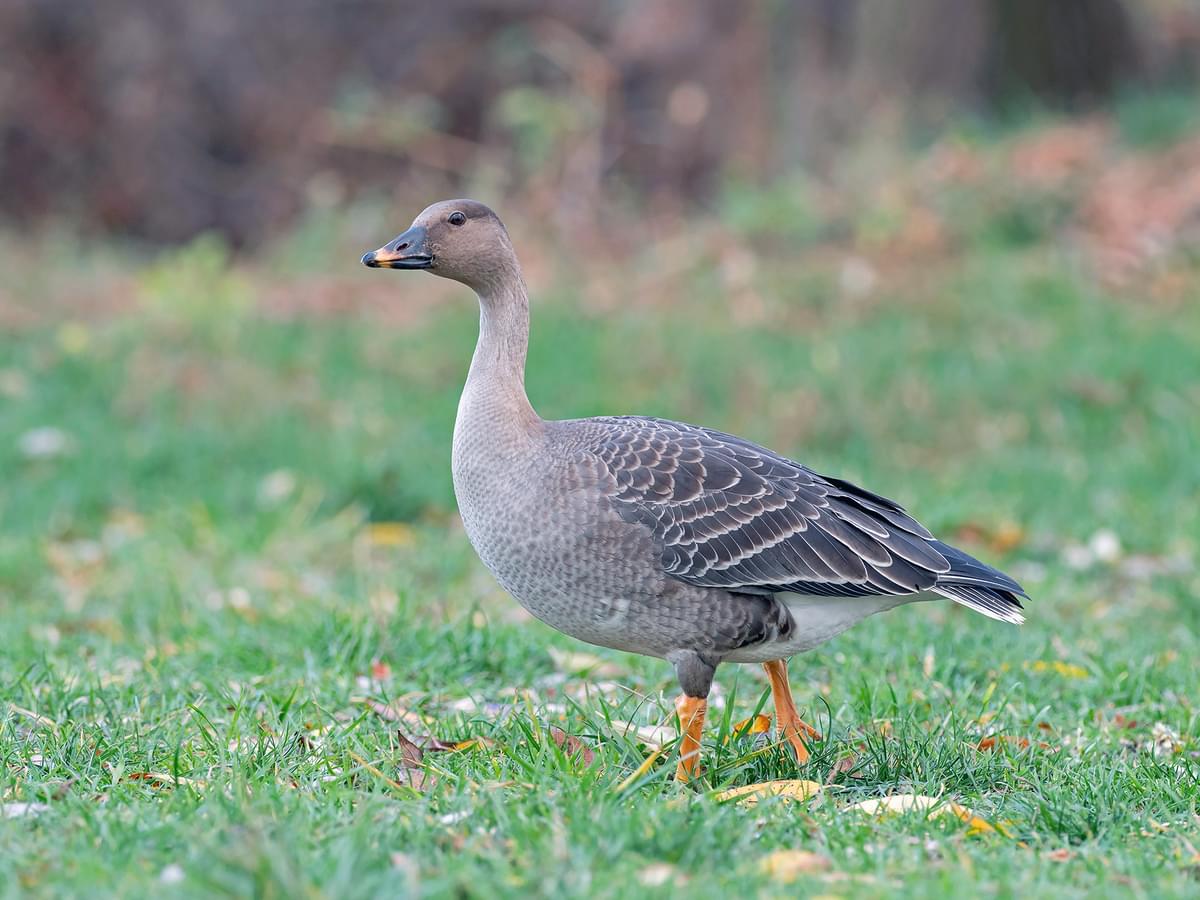
Length
68-88cm
Wingspan
140-174cm
Weight
2-4.1kg
Taiga Bean Goose
The Taiga Bean-goose is marginally more common than the Tundra Bean-goose. It breeds across western Siberia and Scandinavia, with wintering populations in Scotland and East Anglia. Norfolk and Stirlingshire are two reliable spots to see The Taiga Bean-goose between October and March.
The Taiga Bean-goose and Tundra Bean-goose are related, but diverged some 2.5 million years ago. Hybridisation is common, and the appearances of these geese are quite erratic and their plumage highly variable.
Appearance
The Taiga is marginally larger than the Tundra Bean-goose, measuring 68 to 92cm (27 to 35in) with a wingspan of 140 to 174cm (55 to 69in).
They weigh around 1.7 to 4.2kg (3.7 to 8.8lb. It’s predominantly grey-brown with a brown neck and white under tail. The bill is black with an orange patch and strip.
Snow Goose
Anser caerulescens
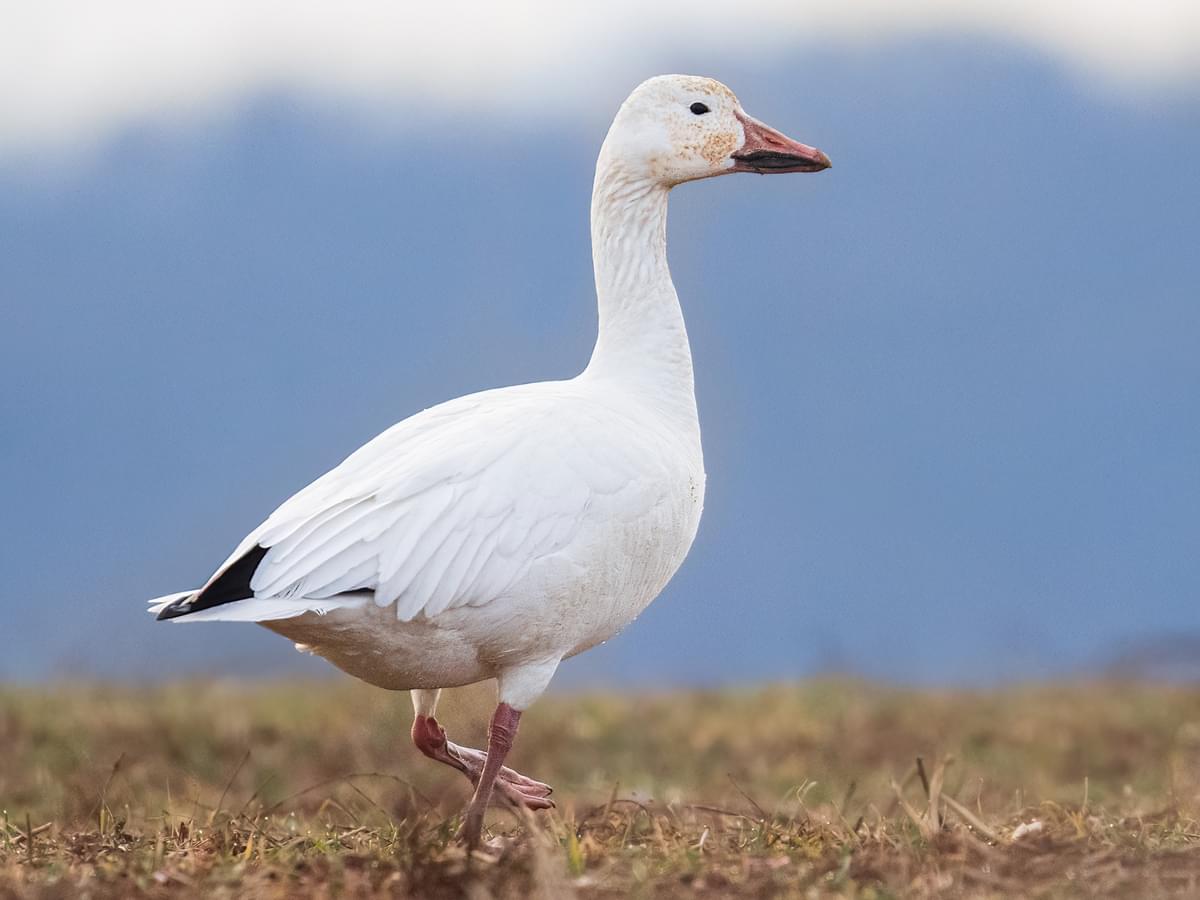
Length
69-84cm
Wingspan
132-165cm
Weight
2.05-3.18kg
Snow Goose
The UK’s least common goose, the Snow goose breeds in Greenland, with populations in Siberia and North Asia. They’re much more common in the US and Canada than on the UK side of the Atlantic.
Small quantities of Snow geese migrate south to Ireland and Scotland, but the majority of the Greenland population actually head west to the US coast.
You’re most likely to see Snow geese on Islay and at Loch of Strathbeg, Scotland, but they occasionally pop up in wintering flocks across the country and are quite distinctive amongst other geese with their bright-white plumage.
There are also some isolated feral breeding populations in Scotland - one small flock breeds in the Inner Hebrides.
In addition, there has been an increase in sightings at Slimbridge, Gloucestershire, with hints that the bird is becoming more common in the UK.

Snow Goose in flight
Appearance
The Snow goose is split into two main subspecies, and one is much larger than the other. The Greenland and European subspecies are the lesser of the two, measuring 64 to 79cm (25 to 31in) tall with a wingspan of 135 to 165cm (53 to 65in). It weighs 2.05 to 2.7 kg (4.5 to 6.0lb).
The Snow goose differs from most wild geese as it has bright-white plumage. There are two colour morphs or forms. One is practically all-white with black wing weathers, whereas the other is white-headed with a greyish body and wings.
It occurs in two colour forms, one all white with black wing feathers which are obvious in flight, the other white-headed with a blue-grey body and wings.
What are geese?
The “true geese” from the waterbird family Anatidae belong to the genera Anser and Branta. Many other waterbirds have the word “goose” in their common name, such as the Egyptian goose, but these aren’t considered true geese.
Geese are larger, heavy waterbirds with robust, rotund bodies, long necks, short bills and large webbed feet.
They’re nearly always larger than ducks, but aren’t as large as most swans. Geese are widely distributed in the Northern Hemisphere and often breed in the cold tundra and Subarctic. They’re tough, hardy birds that often migrate, sometimes committing to non-stop journeys of thousands of miles.
Geese feature strongly in human history and folklore and are highly respected in mythology. Geese symbolise prosperity, goodwill, love and longevity.

A pair of Greylag Geese
Where are the best places to see geese in the UK?
Geese are common throughout the UK. For example, the Canada, Greylag, and Brent goose are relatively easy to spot across the lowlands waterways of England, Scotland, Wales and Northern Ireland. Even the migratory Barnacle goose has been spotted in London.
Norfolk’s wetlands are a perfect place to spot wintering geese, as is The Wash, in East Anglia, the Solway, between Cumbria and Dumfries, and the Ribble, in Lancashire.
If you want to spot a less common Bean-goose or Snow-goose, the Scottish and Irish coastlines are a good bet, as are the Scottish Islands and some of the more coastal Lochs.
What is the largest goose in the UK?
The Greylag goose is a particularly bulky goose, and is marginally larger than the Canada goose on average.
With that said, Canada geese often grow larger, with some exceptional males exceeding 5kg. So it’s a tie - the Greylag and Canada goose are both heavyweights!

Canada Geese are slightly smaller (on average), than the Greylag Goose - however there can be cases where they are larger
What is the smallest goose in the UK?
The Brent goose is one of the smallest species of goose - it’s barely larger than a Mallard duck. They measure around 50cm long and weigh up to 2kg on average.
How many types of geese are there in the UK?
There are nine species of geese that you can see in the UK. However, only one of these species breeds here natively - the Greylag goose.
Most other species of goose are non-native breeders or only visit the UK during winter, after migration.

Brent Geese flock in flight
Are geese protected in the UK?
All wild birds in England and Wales are protected under the Wildlife and Countryside Act 1981. Scotland and Northern Ireland have their own equivalent laws.
There was a general licence to kill Canada geese for public health and safety reasons until 2021, when the government withdrew it.
Are there geese in London?
There are many species of geese in London, including the Canada goose, the Greylag goose, the Brent goose and the Barnacle goose, at least.
If you want to spot geese in London, St. James Park is host to many waterfowl, including Canada and Greylag geese. Barnacle geese have been spotted in Abbey Wood, too.
The London Wetlands Centre in Richmond is another excellent spot for observing geese in the capital.
